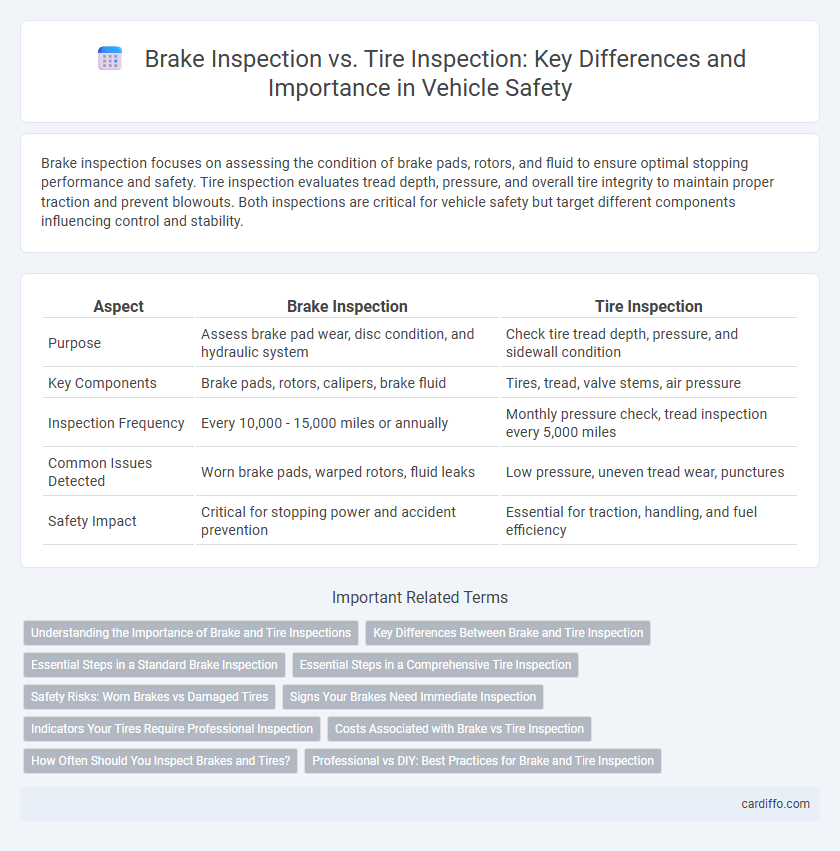Brake inspection focuses on assessing the condition of brake pads, rotors, and fluid to ensure optimal stopping performance and safety. Tire inspection evaluates tread depth, pressure, and overall tire integrity to maintain proper traction and prevent blowouts. Both inspections are critical for vehicle safety but target different components influencing control and stability.
Table of Comparison
| Aspect | Brake Inspection | Tire Inspection |
|---|---|---|
| Purpose | Assess brake pad wear, disc condition, and hydraulic system | Check tire tread depth, pressure, and sidewall condition |
| Key Components | Brake pads, rotors, calipers, brake fluid | Tires, tread, valve stems, air pressure |
| Inspection Frequency | Every 10,000 - 15,000 miles or annually | Monthly pressure check, tread inspection every 5,000 miles |
| Common Issues Detected | Worn brake pads, warped rotors, fluid leaks | Low pressure, uneven tread wear, punctures |
| Safety Impact | Critical for stopping power and accident prevention | Essential for traction, handling, and fuel efficiency |
Understanding the Importance of Brake and Tire Inspections
Brake inspections ensure the vehicle's stopping power remains effective by detecting worn pads, leaks, or rotor damage that could lead to brake failure. Tire inspections evaluate tread depth, pressure, and signs of uneven wear, directly impacting traction, fuel efficiency, and overall safety. Regular inspections of both brakes and tires are critical for preventing accidents and maintaining optimal vehicle performance.
Key Differences Between Brake and Tire Inspection
Brake inspection primarily focuses on assessing the condition of brake pads, rotors, and hydraulic components to ensure proper stopping power and safety. Tire inspection emphasizes evaluating tread depth, sidewall integrity, and air pressure to maintain traction, fuel efficiency, and overall vehicle handling. Both inspections are critical for vehicle safety but target different components and performance aspects, with brakes ensuring effective deceleration and tires providing grip and stability.
Essential Steps in a Standard Brake Inspection
A standard brake inspection involves checking the brake pads for wear, measuring rotor thickness, and assessing brake fluid levels to ensure optimal performance and safety. Inspectors also examine brake lines for leaks and test the brake system's responsiveness through a road test to identify any operational issues. These essential steps in brake inspection differ significantly from tire inspections, which focus on tread depth, tire pressure, and sidewall condition.
Essential Steps in a Comprehensive Tire Inspection
A comprehensive tire inspection includes checking tread depth with a gauge to ensure adequate traction and safety, inspecting sidewalls for cracks, bulges, or cuts that could indicate damage, and verifying tire pressure using a reliable gauge to maintain optimal performance and fuel efficiency. Inspecting tire wear patterns identifies alignment or suspension issues, while examining valve stems for leaks ensures proper sealing. These essential steps distinguish tire inspection from brake inspection, which focuses primarily on rotor and pad condition, brake fluid levels, and system responsiveness.
Safety Risks: Worn Brakes vs Damaged Tires
Worn brakes significantly increase the risk of accidents by reducing stopping power and prolonging braking distance, compromising vehicle control during emergencies. Damaged tires, such as those with cuts, bulges, or insufficient tread depth, elevate the chances of blowouts and loss of traction, especially in wet or icy conditions. Both inspections are critical for ensuring road safety, but brake failures tend to have more immediate consequences, while tire issues may lead to gradual handling problems or sudden tire failure.
Signs Your Brakes Need Immediate Inspection
Squealing or grinding noises, a spongy brake pedal, and increased stopping distances are key signs your brakes need immediate inspection to ensure safety and prevent costly repairs. Unlike tire inspection, which focuses on tread depth, pressure, and wear patterns, brake inspection targets the condition of brake pads, rotors, and fluid levels to maintain optimal braking performance. Ignoring these brake warning signs increases the risk of brake failure, making timely inspection crucial for vehicle safety.
Indicators Your Tires Require Professional Inspection
Visible tread wear, uneven tire wear patterns, and sidewall damage are key indicators that your tires require professional inspection. Low tire pressure, frequent air loss, and unusual vibrations while driving also signal potential tire issues needing expert evaluation. Unlike brake inspections that focus on pad thickness and rotor condition, tire inspections prioritize tread depth and integrity to ensure safe road performance.
Costs Associated with Brake vs Tire Inspection
Brake inspections typically incur higher costs due to the complexity of components like rotors, pads, and calipers requiring detailed evaluation, often ranging from $40 to $100. Tire inspections generally cost less, around $15 to $30, as they mainly involve checking tread depth, pressure, and alignment. Understanding the cost differences helps prioritize maintenance budgets and schedules for vehicle safety.
How Often Should You Inspect Brakes and Tires?
Brakes and tires should both be inspected regularly to ensure vehicle safety, with brake inspections recommended every 10,000 to 15,000 miles or once a year, and tire inspections advised monthly or before long trips to check for proper tread depth and pressure. Brake inspections focus on wear indicators, rotor condition, and brake fluid levels, while tire inspections include examining tread wear patterns and sidewall integrity. Maintaining a consistent inspection schedule helps prevent accidents and extends the lifespan of both components.
Professional vs DIY: Best Practices for Brake and Tire Inspection
Professional brake inspections rely on specialized tools and expertise to detect wear, rotor damage, and hydraulic issues, ensuring maximum safety and performance. DIY tire inspections focus on checking tread depth, air pressure, and visible damage but may miss subtle signs of uneven wear or internal damage. Combining professional brake services with regular DIY tire checks strikes an optimal balance between safety and maintenance efficiency.
Brake inspection vs tire inspection Infographic

 cardiffo.com
cardiffo.com